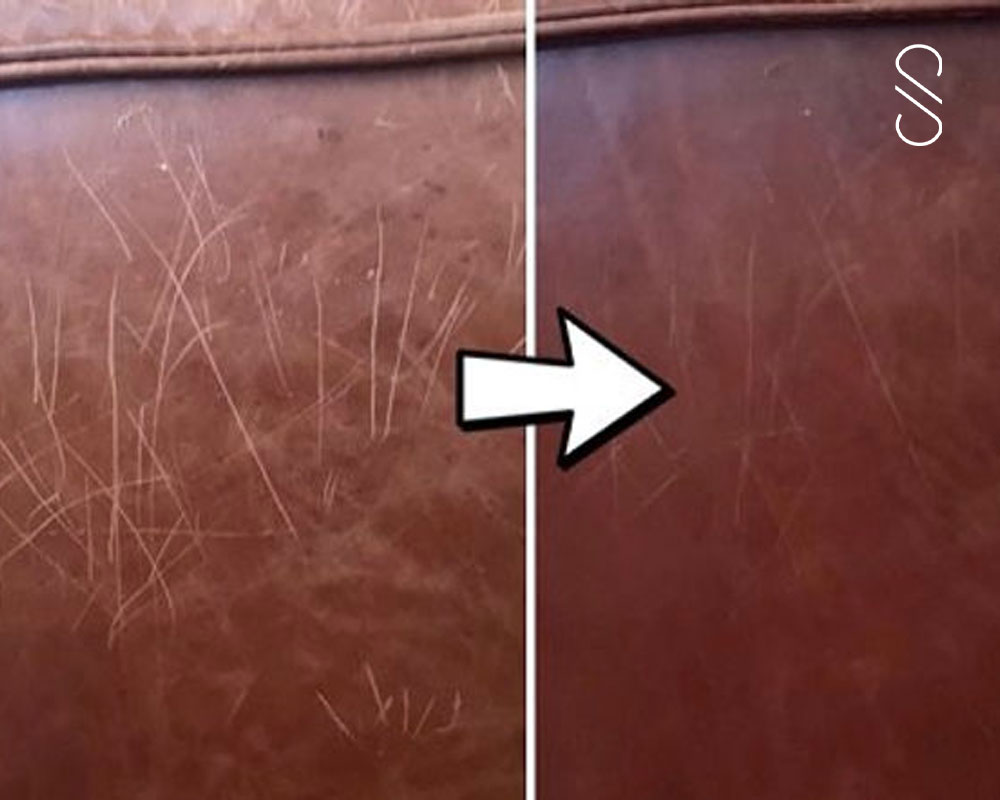How to repair cat scratches on leather with olive oil, start by gently cleaning the scratched area with a soft, dry cloth to remove any dust or debris. Then, apply a small amount of olive oil directly onto the scratch using a cotton ball or microfiber cloth.
Rub the oil into the leather in a circular motion, allowing it to moisturize and darken the scratched surface, which helps blend the mark with the surrounding area.
Let it sit for about an hour, then wipe away any excess oil with a clean cloth. This simple method works best for light surface scratches, but for deeper damage, a leather repair kit may be needed for a more lasting solution.
Estimated reading time: 7 minutes
Key Takeaways:
- Use olive oil to nourish and minimize light scratches on leather furniture
- Proper preparation and cleaning improve repair effectiveness
- Alternative methods like leather conditioners and repair kits handle deeper damage
- Prevention through maintenance and pet care prolongs leather’s life
Table of Contents
- Understanding Scratches on Leather Furniture
- Preparing to Fix Scratches on Leather Couch
- How to Repair Cat Scratches on Leather with Olive Oil
- Alternative Methods to Fix Scratched Leather
- How to Get Rid of Scratches on Leather Effectively
- Conclusion
- FAQ
Understanding Scratches on Leather Furniture
Cat scratches on leather furniture come in two main types:

- Surface-level scratches: These are minor marks that only affect the outermost leather layer. They usually appear lighter than the surrounding leather and feel smooth to the touch.
- Deeper scratches or pilling: These occur when the leather fibers lift, fray, or tear slightly. You may see minor gouges or loose threads in the affected area.
Leather is durable but porous and pliable. This combination means it can withstand everyday use but is vulnerable to sharp cat claws.
Even small scratches can worsen over time if untreated, eventually leading to cracks or permanent damage. That’s why it’s essential to repair damage promptly to protect the leather’s texture, appearance, and lifespan.
For example, untreated scratches can dry out the leather fiber and cause peeling or cracking later on. Addressing scratches quickly helps keep your leather sofa or chair looking smooth and new.
Learn more about leather types.
Preparing to Fix Scratches on Leather Couch
Before treating scratches, gathering the right materials and prepping the scratched area is crucial for effective repair.
Materials Needed:
- Olive oil (the primary home remedy in this guide)
- Soft, lint-free cleaning cloths
- Leather cleaner (to remove dirt and oils)
- Optional: Leather conditioner (to nourish and protect leather after repair)
Step-by-Step Preparation:
-
- Clean the surface thoroughly: Use a leather cleaner on the scratched area to remove dirt, dust, and natural body oils left by cats or humans. This step ensures olive oil can properly absorb into the leather fibers and work effectively.
- Trim loose fibers: If the scratch has caused pilling or raised threads, carefully trim them with scissors. Avoid cutting the leather itself to prevent worsening the damage.
These preparatory steps are essential to maximize the repair effect of olive oil and prevent trapping dirt or residues under the treatment.
How to Repair Cat Scratches on Leather with Olive Oil
Olive oil works by nourishing and moisturizing the leather surface. This natural oil darkens the scratched area temporarily, reducing the visibility of light surface scratches and restoring a more uniform color tone. Olive oil also softens and plumps leather fibers, making scratches less noticeable.
Step-by-Step Guide:
-
- Pour a small amount of olive oil onto a soft, clean cloth. For an extra boost, you can mix olive oil with a little vinegar, but plain olive oil is effective on its own.
- Gently rub the oil into the scratched area using circular, even motions. This encourages the oil to penetrate the leather fibers and cover the scratch.
- Let the olive oil sit on the leather surface for about 5 minutes to allow absorption.
- Afterward, wipe off any excess oil with a dry cloth. This prevents oversaturation and sticky residue.
Important Precautions:
- Avoid using too much olive oil, as over-application can over soften leather or leave a sticky surface that attracts dirt.
- Apply olive oil sparingly and allow the leather to dry fully between treatments.
- Best suited for superficial scratches—not deep gouges or tears, which require more intensive repair.
Using olive oil is a budget-friendly, natural option for reducing the appearance of cat scratches on leather furniture when you act promptly.
Alternative Methods to Fix Scratched Leather
If olive oil doesn’t fully address the scratches, or for deeper damage, several other DIY and professional options exist.
DIY Alternatives:
- Leather Conditioner and Restorer Creams: These products penetrate the leather to plump up fibers and lighten the appearance of light scratches. They often help maintain suppleness and protect against future wear.
- Leather Repair Kits: Kits typically include filler putty, bonding glue, and colorants. These tools are designed for deeper scratches, small gouges, or minor tears. They can fill in damage and restore color to blend the repair seamlessly.
- Vinegar and Olive Oil Mixture: A natural alternative to straight olive oil, the vinegar helps clean and slightly tighten leather fibers while oil conditions the material.
When to Consult Professionals:
For deep scratches, holes, or tears, professional repair is highly recommended. Specialists have access to more advanced fillers, adhesives, color-matching options, and protective sealants that restore functionality and appearance beyond what DIY can achieve.
Sources:
– YouTube Repair Tutorial 1
– YouTube Repair Tutorial 2
How to Get Rid of Scratches on Leather Effectively
Beyond repairing existing scratches, preventing new ones and caring for leather properly improves your furniture’s durability over time.
Maintenance and Prevention Tips:
- Regular cleaning and conditioning: Keeping leather clean and moisturized with suitable products helps maintain its suppleness and resistance to scratches. Conditioning replenishes natural oils lost through wear and exposure.
- Trim your cat’s nails: Shorter nails reduce the chance of deep scratching that can damage leather.
- Use furniture protectors: Employ protective covers or use cat deterrents such as sprays or double-sided tape on areas where your cat tends to scratch.
- Train your cat to scratch elsewhere: Encourage use of scratching posts and provide alternatives to leather couches to protect your furniture proactively.
These steps help reduce the number and severity of scratches on leather furniture, extending its life and saving repair time. Explore leather care styles and tips.
Conclusion
Knowing how to repair cat scratches on leather with olive oil offers a simple, natural solution for minimizing light scratches on your leather furniture. Olive oil nourishes and darkens scratched spots, helping restore a smooth, even appearance. Acting quickly is key to avoid permanent damage and prolong furniture life.
For deeper scratches or extensive damage, professional repairs are the safest and most effective solution. Meanwhile, regular cleaning, conditioning, and pet care can protect your leather couch long-term. Discover more about leather durability.
Try using olive oil as a home remedy to reduce the appearance of minor cat scratches and see how well it works on your furniture. If you have questions or want to share your experience, feel free to leave a comment.
Protect your leather and keep your home beautiful by learning and applying these tested methods for how to repair cat scratches on leather with olive oil.
FAQ
- Can olive oil completely repair deep scratches on leather?
- Olive oil is best suited for light surface scratches. Deep scratches, tears, or gouges require professional repair or specialized leather repair kits.
- How often can I apply olive oil to scratched leather?
- Apply olive oil sparingly and allow the leather to dry fully between treatments. Overuse can cause stickiness or over softening of the leather.
- Is it safe to mix vinegar with olive oil for leather repair?
- Yes, a small amount of vinegar mixed with olive oil can help clean and tighten leather fibers, but plain olive oil alone is effective for light scratches.
- What should I do to prevent cat scratches on my leather couch?
- Regular cleaning, conditioning, trimming your cat’s nails, using furniture protectors, and training your cat to use scratching posts are effective preventive measures.



